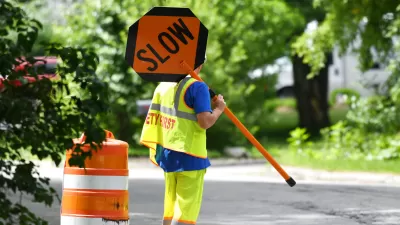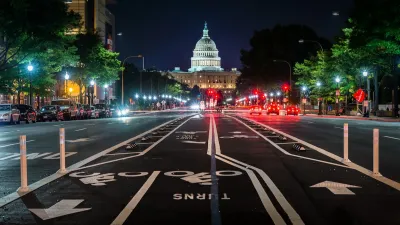Two safe streets advocates give their recommendations for how to effectively use the $1 billion in annual funding available through a federal grant program.

Writing in Streetsblog, Melissa Balmer and Leah Shahum outline some ideas for how cities can effectively put to use the annual $1 billion dedicated to Vision Zero projects through the Safe Streets and Roads for All (SS4A) grant program.
The authors outline the basics of the program: who can apply, due dates, and what kind of projects qualify. Encouragingly, they write, “This is a mercifully streamlined application process, so don’t be daunted! While a 20 percent match is required, there are creative ways to fulfill that requirement.”
Balmer and Shahum suggest ways that communities can use these grants. First and foremost, it’s important to develop a “strong and equitable” Vision Zero plan that “can help your community institutionalize Vision Zero, setting explicit timelines, deliverables, and accountability measures.”
Second, the authors write, “Think Big, Bold & System-Wide for Implementation Projects.” The federal funding can support infrastructure projects that put action plans into literal action, such as “widespread, high-impact, cost-effective design treatments” such as speed humps, improved crosswalks, and other traffic calming measures.
Thirdly, the authors highlight a number of projects that would qualify for supplemental planning grants, such as racial and health equity plans for roadway safety work, reforming traffic enforcement with a focus on safety without over-criminalization, and education on Safe System principles.
FULL STORY: OPINION: How To Use the Money Available for Safe Streets

Study: Maui’s Plan to Convert Vacation Rentals to Long-Term Housing Could Cause Nearly $1 Billion Economic Loss
The plan would reduce visitor accommodation by 25,% resulting in 1,900 jobs lost.

North Texas Transit Leaders Tout Benefits of TOD for Growing Region
At a summit focused on transit-oriented development, policymakers discussed how North Texas’ expanded light rail system can serve as a tool for economic growth.

Why Should We Subsidize Public Transportation?
Many public transit agencies face financial stress due to rising costs, declining fare revenue, and declining subsidies. Transit advocates must provide a strong business case for increasing public transit funding.

How to Make US Trains Faster
Changes to boarding platforms and a switch to electric trains could improve U.S. passenger rail service without the added cost of high-speed rail.

Columbia’s Revitalized ‘Loop’ Is a Hub for Local Entrepreneurs
A focus on small businesses is helping a commercial corridor in Columbia, Missouri thrive.

Invasive Insect Threatens Minnesota’s Ash Forests
The Emerald Ash Borer is a rapidly spreading invasive pest threatening Minnesota’s ash trees, and homeowners are encouraged to plant diverse replacement species, avoid moving ash firewood, and monitor for signs of infestation.
Urban Design for Planners 1: Software Tools
This six-course series explores essential urban design concepts using open source software and equips planners with the tools they need to participate fully in the urban design process.
Planning for Universal Design
Learn the tools for implementing Universal Design in planning regulations.
City of Santa Clarita
Ascent Environmental
Institute for Housing and Urban Development Studies (IHS)
City of Grandview
Harvard GSD Executive Education
Toledo-Lucas County Plan Commissions
Salt Lake City
NYU Wagner Graduate School of Public Service





























